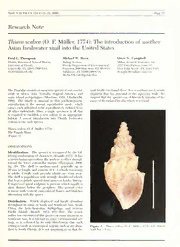
Thiara scabra (O. F. Muller, 1774): The introduction of another Asian freshwater snail into the United States PDF
Preview Thiara scabra (O. F. Muller, 1774): The introduction of another Asian freshwater snail into the United States
THE NAUTILUS 123(l):21-22, 2009 Page 21 Research Note Thiara scabra (O. F. Miiller, 1774): The introduction of another Asian freshwater snail into the United States Fred G. Thompson Michael W. Heyn Drew N. Camphell Florida Museum of Natural Ilistoi'v, Biolo^ Seetiou, Miliau, Swaiu & Associates, liie. Uuiversih'ol Florida, Florida Department of Eu\'iroumeutal 2257\hsta ParWay, Suite 19 Gaiuesville, FL32611-7800 USA Proteetiou2600 BlairStoue Rd. MS 6.515 \\’est Palm Beach ' !•L33411 USA [email protected] Tallahassee. FL;32.3y9-2400 USA ([email protected] Michael.Me\[email protected] TlieThiaridaeconsistsofnumerousspeciesof non-marine snail finallywas found there. It is a medium-sized, ornate snails in Africa, Asia, Australia, tropical America, and organism tliat lias potential in the a(|uarium trade. We many island archipelagoes (VIorrison, 19.54, Glanbrecht, suspect that the species was deliberately introduced be- 1999). The family is nnnsnal in that parthenogenetic cause ol the i.solated localih’where itis lound. reproduction is the normal reproductive mode, which causes each indi\idnal to be reprodnetively isolated from all other individuals. Thus, a single specimen is all that is re(}uired to establish a new colony in an appropriate habitat. A recent introduction into Florida fresliwater systems is one such species. T]tiarascabra (O. F. Aliiller, 1774) The PagodaTiara (Figi.ire 1) OBSERVATIONS Identification: The species is recognized by the fol- lowing combination ofcharacters (Brandt, 1974). ft has a neomelanian operculum: the nucleus is offset strongly toward the lower columellar margin (Thompson, 2006: fig. 38). The shell is medium-sized, generally up to mm 20 in length, and cousi.sts offi—8 whorls remaining in adults. Usually early juvenile whorls are worn away. The shell is pagodiform with strongly shouldered whorls that bear regularly spaced stout spines or knobs. Strong- ly impressed spiral sculpture is present, which usually is most distinct below the peripheiy. The ground color is tawny watli vertical, rust-colored (lames and blotches alternatingwith the spines. Distribution: Widely deployed and locally abundant throughout its range in South and Southeast A.sia, Soutli China, the Indo-Australian Archipelago, and westei'n Pacific Islands (Brandt, 1974; 163—164). The senior authorhas encountered this species on manyoccasions in Southeast Asia. It is tolerant to many environmental set- tings, as is reflected by its wide distribution. One such settingis canals in semitropical regions, such as ai'e abun- Figure 1. Thiara scabra (O. F. Miiller, 1774), UF 391616. dant in South Florida. It is not surprising to us that the Scale bar = 1 cm. Page 22 THE NAUTILUS, Vol. 123, No. 1 Discussion: On September, 2006, specimenswere first Greek, and means a tiara. Thiara scabra possess a coro- collectedbyTodd Ennis andCheri Hughes ofTetraTech, naofspines on the shoulderofthewhorls reminiscent of Inc. at the Port Mayaca Aquifer Injection well site a tiara. (UP 391616). The Port Mayaca site is located in the noithwest corner of Section 14, Towiship 40 South, Range 37 East, near the connueiice of the L-65 Canal ACKNOWLEDGMENTS and St. Lucie River (C-44 Canal) in the Town of Port Mayaca, Martin Co., Plorida (26°59'17" N, S0°36'22" W). We thank Rob Lasley, Plorida Museum of Natural Thesiteis locatedon a South Ploi'idaWatei- Management Histoiy, for photographing Eigure 1. District (FWMD)-owned parcel of land adjacent to the S-153 spillwayand lock, which conveys waterto and from LITERATURE CITED the L-65 Canal and the St. Lucie River. The location is approximately2,000feeteastofthe Herbert HooverDike, Brandt, R. A. M, 1974. The non-marine aquatic Mollusca of south of the sendee access road, and appro.ximately 100 Thailand. Archi\’ fiir Molluskenkunde 105: 1—423. feetwest ofthe intersectionwith the L-65 canal. Property Glaubrecht, M. 1999. Systematics and the evolution of totDhoeungortSltiriosmunodleWractuelrtivaantdionAiorfRseugsaerarccahneW.ater & Air \T'hii\'airpiardiatyeisnentsroupilcaatlo)f—reasnhwoavteeirwigeaws.trCoopuordiser(CFeorristhcihouindgesa-: Research, Inc., Gaines\111e, Plorida. reports to us that a Institut Senckenherg215: 91—96. co-worker, Laura Line, collected this snail in the West Morrison, J. P. E. 1954. The relationships of Old and New Palm Beach Canal, 5 kilometers from its junction wdtli ^Vorld melanians. Proceedings of the United States Lake Okeechobee on April 10, 2007. National Museum 103 (3325): 357—394. Reeve, L. [A.] 1859—1861. Monograph of the genus Melania. Conchologica Iconica; or illustrations of Vernacular Etymology: The vernacular name Pago- the shells of molluscous animals, vol. 12, Melania-, pis. da Tiara is taken from Reeve (1860, pi. 26, fig. 182), 1-59. from a name he proposed for a common form of this Thompson, F. G. 2006. An identification manual for the fresh- species. Tiara comes from the generic name Thiara, water snails of Florida, http://www.flmnh.utl.edu/malacol- which is derived from Persian through the Classical og}7fl-snaiPsnailsl.htm. AccessedJuly26, 2007.
